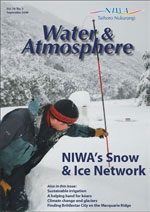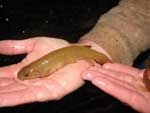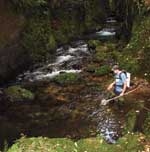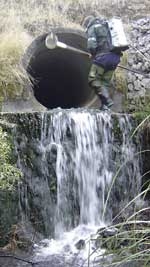PDF of this article (350 KB)





Dave Rowe, Josh Smith, and Shane Grayling put the case for restoration of a native fish in New Zealand lakes.
The kōaro (Galaxias brevipinnis) was once abundant and the dominant fish in the Te Arawa lakes near Rotorua in New Zealand’s North Island. Māori harvested both adults (kōkopu) and juveniles (inanga), using nets and traps crafted from flax and native woods. They developed ingenious methods to catch these fish, and fishing grounds were named, marked, and vigorously protected, as were the nets they used. As a major source of protein, the kōaro fisheries were an integral part of tikanga and were a taonga species for Te Arawa.
When management of the Rotorua lakes was returned to Te Arawa in the Te Arawa Lakes Settlement Act 2006, the status of kōaro was unknown and there was little information on which to base future management of this species. Since then, NIWA has been investigating the fish’s current status for the Te Arawa Lakes Trust through a series of stream surveys.
Life history of kōaro in lakes
The kōaro’s long cylindrical body is well adapted for moving and burrowing through the rocks and cobbles of stream beds and this helps it to avoid displacement by fast flows. This is why adults are common on the bottom of the fast-flowing reaches of many streams. Kōaro spawn in streams and the larvae are washed out to the sea. There they feed on plankton for about six months before the juveniles return to the river as whitebait and migrate upstream to adult habitats. Kōaro living in the Rotorua lakes are landlocked and isolated from sea-going stocks. Adults live in the inlet streams as well as in the lake. The lake acts as an ‘inland sea’ for the development of larvae and juveniles, and the adults spawn in the inlet streams.
As migrant juveniles, kōaro are excellent climbers. They can ascend steep falls and penetrate far inland to higher altitudes than most other native fish. This is how kōaro colonised most inland lakes draining to the sea, including Lake Rotoiti and Lake Tarawera. But how could kōaro colonise lakes with no connection to the sea? Stocking is the only answer and it’s apparent that in the past Māori stocked a number of the Rotorua lakes with kōaro to provide a food source.
Causes of decline
In the early 1900s, brown trout and rainbow trout were introduced to the Te Arawa lakes and the kōaro fisheries collapsed because of heavy trout predation on kōaro. But predators rarely eliminate their prey and the kōaro stocks remained at a low level until the 1930s, when smelt were introduced as a forage fish for trout. This introduction enhanced the trout fisheries but it was the death knell for kōaro. Smelt out-competed inanga for the plankton they both eat and also preyed on kōaro larvae. Kōaro became rare or extinct in these lakes, retreating to the few inlet streams where a native bush canopy remained and where trout access was limited. That is, until the bush was cleared for pasture: then kōaro disappeared from these streams as well!
Lake-dwelling kōaro today
Our recent surveys have increased the known stream populations of kōaro from 12 to 16, but revealed that kōaro are now extinct in four lakes and probably extinct in another six. Relict populations are confined to a few inlet streams in another four lakes, and kōaro are secure only in Lake Okataina, where they are common in all six of the inlet streams. These findings confirm a dramatic loss in the indigenous biodiversity of these lakes and indicate that this taonga species is on thebrink of extinction in all but one lake. The loss of landlocked kōaro populations is not confined to the Te Arawa lakes. Other NIWA studies have shown that kōaro have also declined or disappeared in most other New Zealand lakes where trout and or smelt are now present. Landlocked, lake-dwelling stocks of kōaro are heavily depleted nationwide, so it is high time to halt the decline and, where possible, restore lost populations.
Restoration options
Restoring lake populations of kōaro will not be possible in many lakes because they contain valued trout fisheries or else the lakes are too large to remove all trout and smelt. But some small lakes are not as highly valued for trout fisheries as others: here restoration of kōaro may be possible if the trout and smelt can be eradicated with pesticides that target fish.
In lakes where trout fisheries are important, the only feasible restoration of kōaro populations is in the inlet streams, and this is now being undertaken in Lake Rotoaira near Taupo. Restoration techniques include:
- excluding trout from the small streams that are not required to sustain the trout population
- creating stream habitat for kōaro by planting riparian (streamside)strips with trees
- re-establishing kōaro in streams where they are now gone.
Trout exclusion involves creating barriers to fish migrating upstream and then removal of trout from above these. Such barriers have been used successfully in the USA, Australia, and New Zealand to protect indigenous fish from trout; they won’t exclude migrating kōaro because they are such excellent climbers.
We believe some restoration is both feasible and necessary to protect and enhance the stocks of this former taonga species before it declines further and extinction occurs in even more of the Te Arawa lakes.
Helping hand – or a leg up?
- Once abundant in the Rotorua lakes, kōaro stocks were a major food source for local Māori.
- Kōaro populations in the lakes have declined since the introduction of trout and smelt.
- Kōaro’s climbing ability can be used to help restore lake populations.
Further reading and useful links
McDowall, R.M. (2003). The key to climbing in the koaro. Water & Atmosphere 11(1): 16–17.
Rowe, D. K. (1993). Disappearance of koaro, Galaxias brevipinnis, from Lake Rotopounamu, New Zealand, following the introduction of smelt, Retropinna retropinna. Environmental Biology of Fishes 36: 329–336.
Rowe, D.K.; Konui, G.; Christie, K. (2002). Population structure, distribution, reproduction, diet and relative abundance of koaro (Galaxias brevipinnis) in a New Zealand lake. Journal of the Royal Society of New Zealand 32: 275–291.
Rowe, D.K.; Graynoth, E.; James, G.; Taylor, M.; Hawke, L. (2003). Influence of turbidity and fluctuating water levels on the abundance and depth distribution of small benthic fish in New Zealand alpine lakes. Ecology of Freshwater Fish 12: 216–227.
Te Arawa Lakes Trust: www.tearawa.iwi.nz
Te Arawa lakes sustainable management programme: www.niwa.co.nz/maori/research/te_arawa_lakes
Dr David Rowe is a freshwater fisheries scientist specialising in native fishes and their habitat. Josh Smith and Shane Grayling are fisheries technicians. They are all based at NIWA in Hamilton.
This research is part of ‘Sustainable Management Framework for Te Arawa Lakes Customary Fisheries’, a programme funded by the Foundation for Research, Science and Technology and the Health Research Council, focused on traditional species of the lakes. We are grateful to the Te Arawa Lakes Trust for their ongoing support of this research.
Teachers’ resource for NCEA Achievement Standards or Unit Standards: Education for Sustainablity Level 2 AS90811, AS90813, AS90814, AS90815 Geography Level 3 AS90703 Biology Level 1 AS90165, US6297, Level 2 AS90813, US6309
